Sino-Indian relations span back in time to ancient history. However, modern bilateral relations began in 1950 when India was amongst the first countries to recognize the People’s Republic of China as a legitimate nation state. Today, India and China are two of the most populous nations and the fastest growing economies in the world. Although the relationship between these two countries have generally been cordial, it has become strained at times due to unresolved border issues and high economic competition. Nonetheless, diplomatic and common economic interests continue to heavily influence the ties between these two Asian giants.
Separatists and Splittists
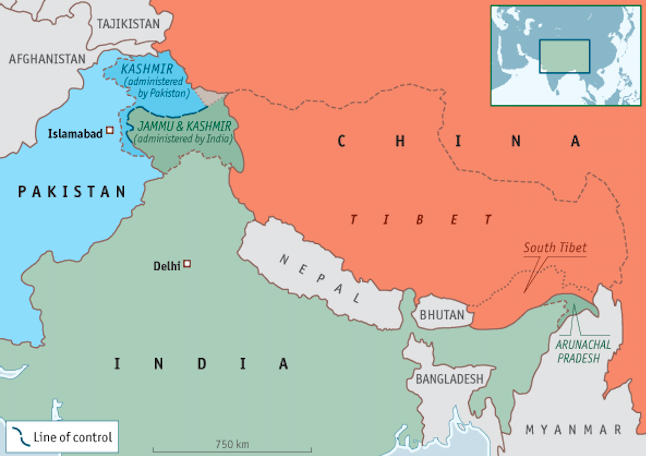
Map indicating the location of Pakistan, India and China. Politics in the region have always been highly charged, thanks to territorial disputes and economic competition between India and China.
To fully understand the present dynamics in the region, one must first receive a short history of the relationship between these two nations. In 1947, India became independent with the end of British colonial rule. Shortly after her independence, India’s Muslims opted to secede from India, forming instead a new nation by the name of Pakistan. This traumatic event, now known as the Partition, saw millions of people displaced from their homes, as Hindus from newly-formed Pakistan fled to India, and Muslims from India left for Pakistan. Since that time, India and Pakistan have been at odds over many issues, including the respective nations’ nuclear armaments as well as territorial disputes over the border region of Jammu and Kashmir (J&K) in North West India.
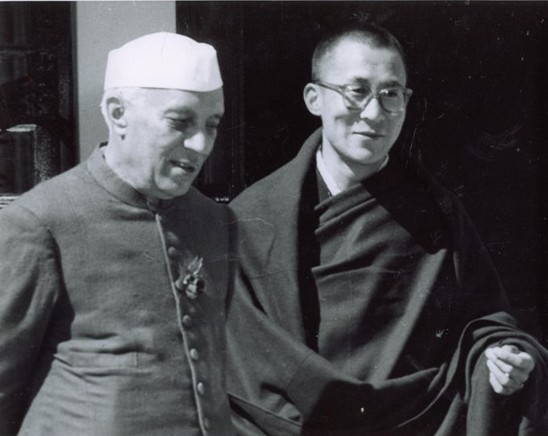
His Holiness the 14th Dalai Lama with the first Prime Minister of India, Jawaharlal Nehru. It was under Nehru’s leadership that India first extended assistance to the Tibetans. In the last 60 years, this assistance has since waned as the Indian government has gradually realized that supporting the Tibetans does not bring any tangible benefits to the 1.2 billion Indian citizens who have their own domestic issues to contend with.
In the J&K issue especially, India considers Pakistan to be separatists because they actively encourage the secession of the state. India has also previously accused China of covertly supporting Pakistan’s interests in the matter, deeming it to be an affront to India’s sovereignty that China might attempt to influence their domestic issues.
Conversely, China has previously accused India of interfering with Chinese domestic issues through Indian support for His Holiness the Dalai Lama and the Central Tibetan Administration (CTA; Tibetan leadership based in Dharamsala). China considers the Dalai Lama a ‘splittist’, and they cite the CTA’s encouragement of independence protests as evidence of their intention to destabilize the Tibet Autonomous Region. On repeated occasions, China has also expressed their displeasure at the Dalai Lama being a guest of India.
High Stakes Tit-for-Tat
So despite their shared political, cultural and economic prowess, India and China have had to contend with many factors creating friction in their relationship. Ties between these two Eastern giants further deteriorated in 2017, sometimes nearly bordering on open conflict.
In 2017, China accused the Indian leadership of allowing the Dalai Lama to visit the disputed border region of Arunachal Pradesh in North East India. The visit to the Indian state, which borders with China, was viewed by Beijing as being deliberately provocative. The Chinese leadership also took issue with the fact His Holiness was received by the highest state authorities there, the Chief Minister Pema Khandu and Minister of State Kiren Rijiju. This followed an incident in 2016, when His Holiness shared the stage with the then-Indian President Pranab Mukherjee. In all of these meetings, India insisted that it was merely a meeting with a religious leader; China, on the other hand, viewed the meetings as official support for the Dalai Lama’s stance.
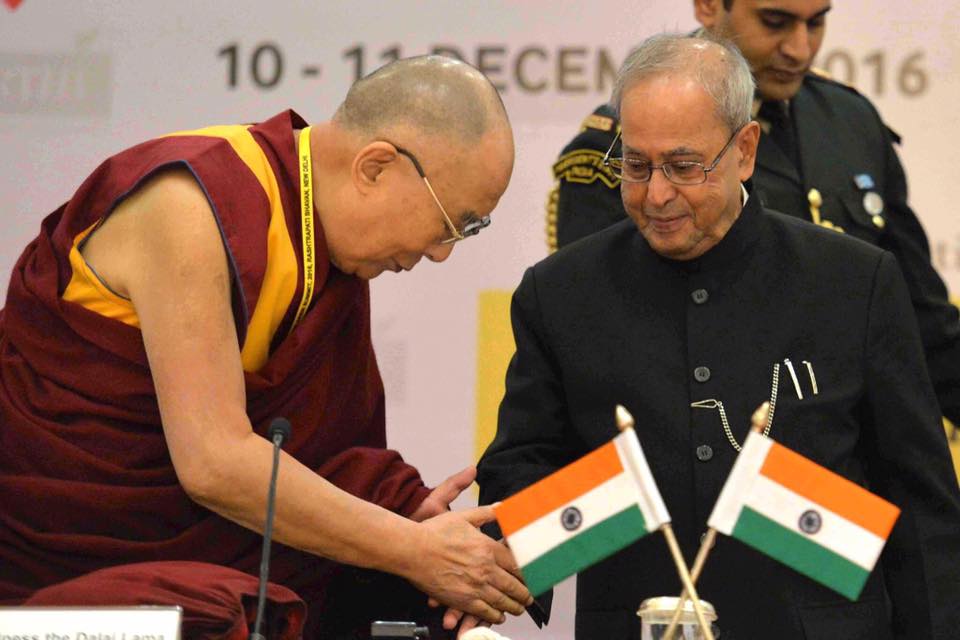
His Holiness the Dalai Lama with the then-Indian President Pranab Mukherjee. This incident put a strain on China-India relations, as China viewed the meeting as official support for the Dalai Lama’s stance.
In response, China cancelled their Foreign Minister’s visit to India and stopped sharing hydrological data on the Brahmaputra. Relations after this failed to normalize, instead continuing to further deteriorate until the Doklam issue, when both nations became engaged in a border standoff that nearly came to blows. The world held its breath as they watched both Asian tigers decide instead to stand down, for the wider benefit of political stability in the region.
Encouraging 2018
Given the strained Sino-India relations as of late, 2018 has begun with some encouraging signs that both Asian giants are reaching out to one another in the spirit of cooperation and compromise.
First, despite initial objections, China finally lent their support towards Pakistan’s designation as a ‘terrorist state’. Now on the ‘grey list’ of the Financial Action Task Force, it has opened the door for Pakistan to be penalized for their failure to halt financial transactions by terrorist groups. It will make it more difficult for Pakistan to access international financing, and perhaps embolden nations to levy economic sanctions against them. China has also signaled that they will no longer unconditionally support Pakistan, a move which has been met with delight from India. It was India who strongly lobbied China and the United Nations for all of this to happen, and for China to agree to support India in these initiatives was a great concession from Beijing to India.
Also in February, foreign secretary Subrahmanyam Jaishankar, who was in Beijing for bilateral strategic dialogue, told Indian media that China was “open” to India joining the Nuclear Suppliers Group but there were “procedures and processes” to be completed. Traditionally, China has blocked India’s admission into this elite group. Therefore, this was another great concession from China to India, and a clear sign of the thawing relations between the two great economic giants. India, being very pleased with the two ‘favors’ from China, has been set to reciprocate.
Following all of this news, a leaked memo has come to light suggesting that the Indian government is interested in a reciprocal relationship with the Chinese. On 26th February 2018, a classified directive from Indian Cabinet Secretary the Honorable Pradeep Kumar Sinha was leaked to the press. Addressed to various senior leaders and government officials, the directive detailed his discouragement of Indian officials attending events held by the Tibetan leadership in India, especially those marking their 60 years of exile in the country.
As it turns out, this directive was in response to a note Sinha received from the Indian Foreign Secretary, the Honorable Vijay Gokhale, just four days earlier. The note stated that it is now a “sensitive time” for bilateral relations between the two Asian giants – India and China. A day after his note to Sinha, Gokhale left for Beijing for talks with Chinese Vice Foreign Minister Kong Xuanyou and meetings with his Chinese counterparts. It had been nearly a year since such a standalone visit had taken place.
Despite initial objections, China allowed Pakistan to be put on the ‘grey list’ of the Financial Action Task Force…[Alka] Acharya believed that given that the foreign secretary’s note to the cabinet secretary went out a day before he left for Bejing, “there seems to be a prima facie case for a quid pro quo having occurred”.
What does this mean for Tibetans and Dharamsala?
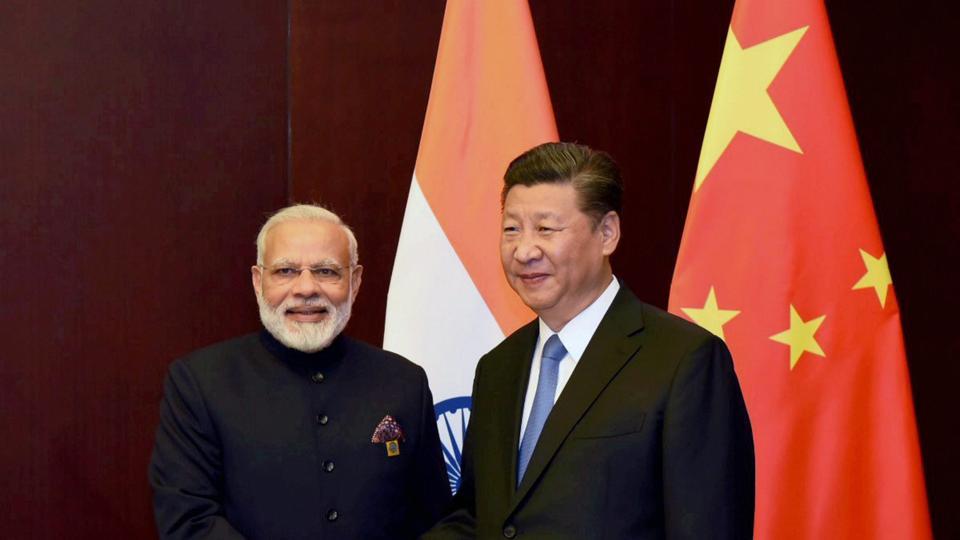
Indian Prime Minister Narendra Modi and Chinese President Xi Jinping. As time goes on, the relationship between the two leaders as well as their respective nations continues to improve, for the benefit of their people and the region.
The message to the Tibetans is clear: ultimately, India considers Tibet to be a political pawn and while they might respect His Holiness as a spiritual teacher, their interests in Tibet do not extend beyond religion. It is worth keeping in mind that:
- India has not denied the leaked memo. Instead of an outright denial, and embarrassed by the leak of this confidential information, the Indian leadership scrambled to cover their bases by reinforcing their stance on the Dalai Lama as a religious personage. So the Indian leadership instead chose to reaffirm their stance of respect and reverence for the Dalai Lama as a religious leader, and remained silent on their stance regarding the Central Tibetan Administration (CTA) and on the circular’s contents itself.
- If the memo is a fake, they would say so. But they did not. If the leaked memo was a forgery, India would have immediately issued a statement to that effect. They would not have any qualms about denying it. The fact they did not invalidate calling the memo a fake, and the fact they did not deny the memo’s existence means the memo is real. Denying it would send a confusing message to their ministries and to China, because it actually really is their policy now.
- The CTA’s willingness to be used as a thorn in China’s side has backfired on them. Though an effective short-term policy, ultimately the CTA has no power of their own, relying on India’s support to uphold any provocative statements that they make. It is like a small child in a playground going to poke the bigger child; they rely on their parents to support their behavior, and it is their parents’ support that emboldens them. One day however, when the parents lay down the gauntlet and refuse to continue supporting their child’s disruptive ways, the child is forced to become meek and quiet, the wind taken out of his sails. In the same way, India appears to be rescinding their support for their errant Tibetan child and is instead choosing to prioritize the greater interests of their 1.2 billion citizens. At the end of the day, all the CTA has to look forward to is a very upset Chinese leadership whom they have spent 60 years antagonizing, with no results to show for it at all.
- India has never willingly fought a conflict on behalf of the Tibetans. If India’s support was real and complete, it would extend beyond financial and social assistance. Given that no country, including India, has ever gone to war with China over Tibet, this speaks volumes of the lack of genuine support for the Tibetan cause. For example, in order to topple the corrupt regime of Saddam Hussein, various military forces from around the world invaded the country to oust him. If Tibet was such an important issue for India, or indeed anyone else, they would have done the same for the Tibetans. Clearly everyone, including India, cares more for amicable relations with China than the Tibetan cause.
- Both public and political favor is moving against the Tibetans. Domestically, 2017 saw public anti-Tibetan protests organized by large bodies of students in Arunachal Pradesh in North India. Indian members of parliament also began questioning the Dalai Lama’s silence over Indian domestic issues, whilst the Indian government made it easier for Tibetan refugees to become Indian citizens. Now, international political tides are shifting towards better relations with China. Is this the beginning of the end for the Central Tibetan Administration’s (CTA) support in India? Internationally, the USA has dramatically lessened their funding for the CTA, and country by country are rejecting the Tibetans in one way or another. As India, historically the CTA’s biggest supporter, shifts its focus to China, the Tibetans-in-exile will soon lose their support altogether, leaving them nowhere else to turn to.
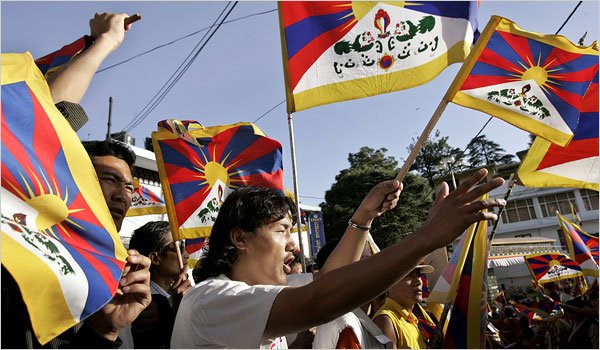
If the Tibetans continue to protest, make demands of India and provoke China, India may be compelled to intervene so as to avoid further strain on the Sino-Indian relationship.
Some might argue that the memo is premature. Events marking the 60th anniversary of the Tibetans’ exile are yet to take place, so they could still be attended by Indian officials and dignitaries. If the officials do end up attending, it will only be because the Indian government is incredibly politically astute. Since the memo has been leaked and in order to counter any public discontent, it would not be surprising if some officials end up attending the events. They would not want to be seen as caving in to Chinese demands.
Ultimately however, there is no benefit to either China nor India to support the Tibetan cause; as the United States loses favor globally, a vacuum of influence is left behind that is just waiting for these two powerhouses to fill. Thus, cooperation between China and India would be mutually beneficial, and result in political and economic stability for one third of the earth’s population. By comparison, the Tibetan cause is too small of an issue for any country to derail their political and economic interests.
But nevertheless, it does mark a significant shift in India’s stance.
It is time the Central Tibetan Administration (CTA) realizes that they gain nothing by criticizing the Chinese leadership and their policies, but in fact only make things worse for themselves. Traditionally, the CTA has allocated a significant budget for social media, aimed at destroying the reputation of those they label their opponents. Clearly however, their efforts have been in vain and the reputation of their targets, instead of degenerating, continues to improve. And so, for example, if it transpires that the Dalai Lama’s travels continue to disrupt Indian foreign policy, the leadership in Delhi may see it fit to limit his movements within India or even rescind funding. Making further demands of the Indian government, therefore would only serve to add to the litany of reasons why India should no longer support the Tibetan leadership, and maybe even hasten the process.
Faced with this inevitability, it would instead be more logical for the CTA to formulate alternative plans if they are serious about preserving Tibetan religion, culture and traditions, as they have declared to do for 60 years. The fact is that Tibetans are not Indian, and they are not American, Canadian, Swiss, Italian, etc. Returning to Tibet would give them the best chance of succeeding. To do this, they would have to undo six decades of damage and instead start to befriend China, to make their passage back to Tibet possible. The longer they remain in exile, the faster the loss of their culture and traditions as more and more Tibetans assimilate into their host nations. With the reducing Indian support, it is time the Tibetan leadership seriously takes on a different approach, before it is too late and they have nowhere to go.
Media Coverage of the Indian Government’s Memo
[WORLD IS ONE NEWS] India: Dalai Lama free to carry religious activities
[NDTV] Indian Minister of State for Home Affairs declines to comment on ‘Skip Dalai Lama events’ report
[NDTV] No Change In Stand, Says Centre After ‘Skip Dalai Lama Events’ Report
[THE INDIAN EXPRESS] Government asks to skip Dalai Lama events, attempts to mend fences with Beijing

Click to enlarge (Source: http://indianexpress.com/article/india/govt-asks-to-skip-dalai-lama-events-attempts-to-mend-fences-with-beijing-5083439/)
[THE INDIAN EXPRESS] Govt sends out note: Very sensitive time for ties with China, so skip Dalai Lama events

Click to enlarge (Source: http://indianexpress.com/article/india/govt-sends-out-note-very-sensitive-time-for-ties-with-china-so-skip-dalai-lama-events-5083430/)
[TIBETAN JOURNAL] Indian Ministers, Officials Told to Avoid Dalai Lama Events!
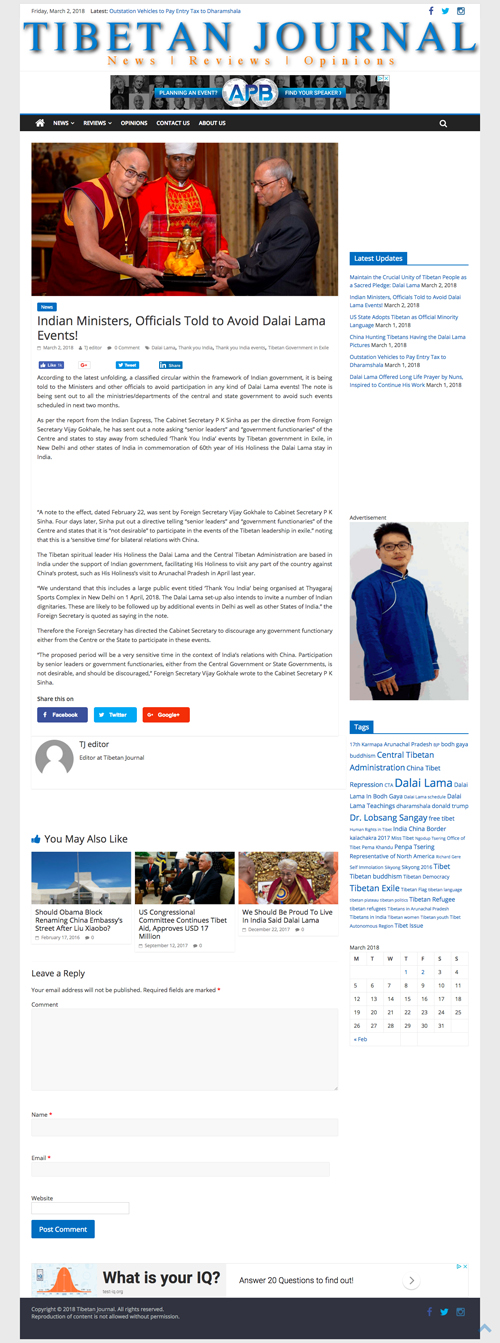
Click to enlarge (Source: http://www.tibetanjournal.com/index.php/2018/03/02/indian-ministers-officials-told-avoid-dalai-lama-events/)
[ABC NEWS] Report: Indian officials told to avoid Tibetan exile events
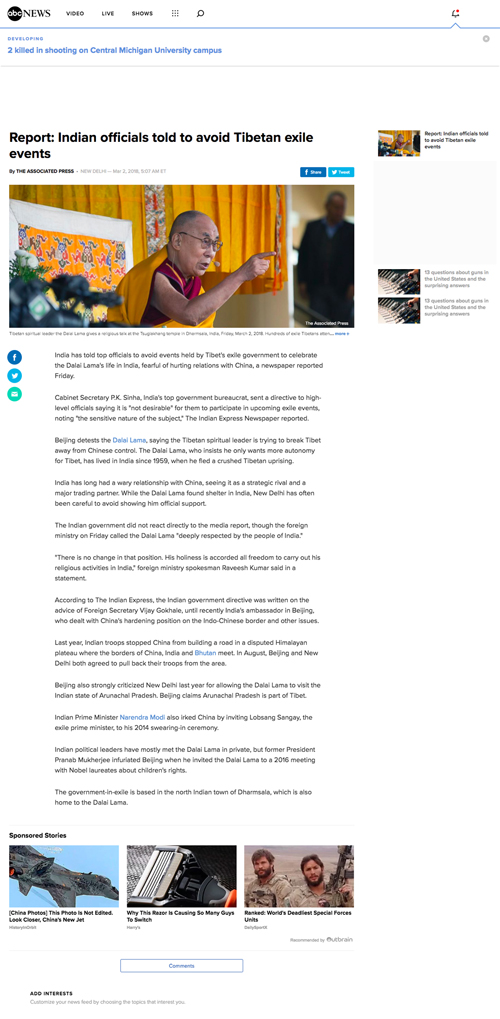
Click to enlarge (Source: http://abcnews.go.com/International/wireStory/report-indian-officials-told-avoid-tibetan-exile-events-53458546)
[THE TIMES OF INDIA] Government denies change in stance on Dalai Lama to please China

Click to enlarge (Source: https://timesofindia.indiatimes.com/india/government-denies-change-in-stance-on-dalai-lama-says-he-is-accorded-all-freedom-to-carry-out-his-religious-activities-in-india/articleshow/63135041.cms)
[TIBET SUN] Cautious India to skip Tibetan events marking 60 years of exile

Click to enlarge (Source: https://www.tibetsun.com/news/2018/03/02/cautious-india-to-skip-tibetan-events-marking-60-years-of-exile)
[THE TIMES] Indian officials told to snub
Dalai Lama amid tensions with China

Click to enlarge (Source: https://www.thetimes.co.uk/article/indian-officials-told-to-snub-dalai-lama-amid-tensions-with-china-jxl8x8mzw)
[ANI] Dalai Lama should stick to religious activities: Swamy
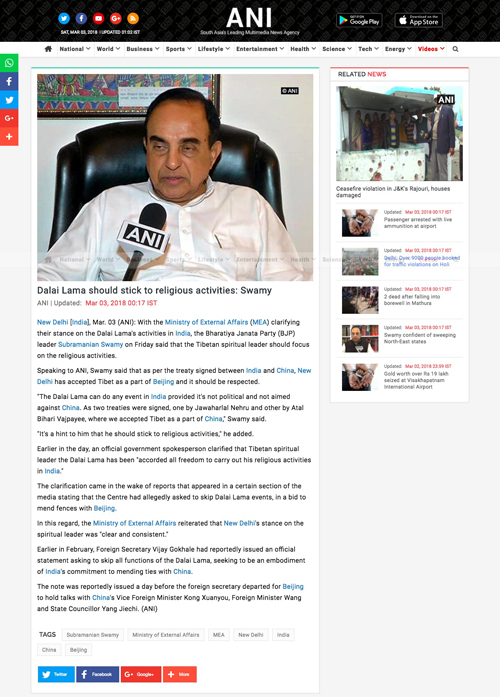
Click to enlarge (Source: https://www.aninews.in/news/national/general-news/dalai-lama-should-stick-to-religious-activities-swamy201803030017190003/)
[THE WIRE] Decoding the Puzzle of the
Indian Govt Circular Distancing Itself From Dalai Lama Event

Click to enlarge (Source: https://thewire.in/229509/experts-unravel-the-puzzle-of-indian-govts-circular-on-distancing-from-dalai-lama-event/)
[THE QUINT] India’s Stance on Dalai Lama Reveals Dynamics With China

Click to enlarge (Source: https://www.thequint.com/voices/opinion/opinion-dalai-lama-mea-indian-govt-60-years-exile-event-china-tibet-relationship)
Addendum – Breaking News!
The Indian Foreign Secretary the Honorable Vijay Gokhale, who issued the initial directive advising Indian officials against attending events hosted by the Tibetan leadership, has been working on a high-level visit from China to India. The long-awaited visit is intended to reset the two nations’ relationship and stabilize ties.
[LIVE MINT] India working on high-level visit from China to stabilize ties
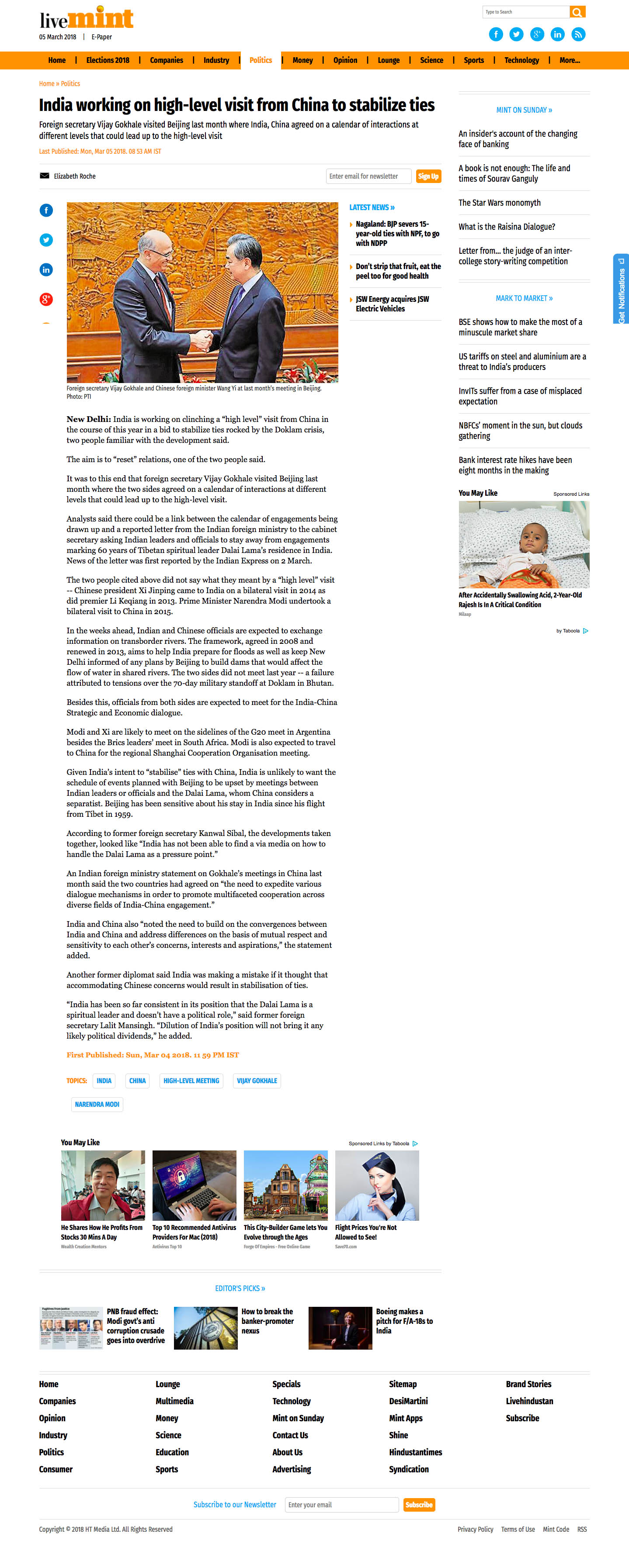
Click to enlarge (Source: http://www.livemint.com/Politics/uoEgEcdPYdTxWe8dcXrIEK/India-working-on-highlevel-visit-from-China-to-stabilize-ti.html)
MORE NEWS LIKE THIS